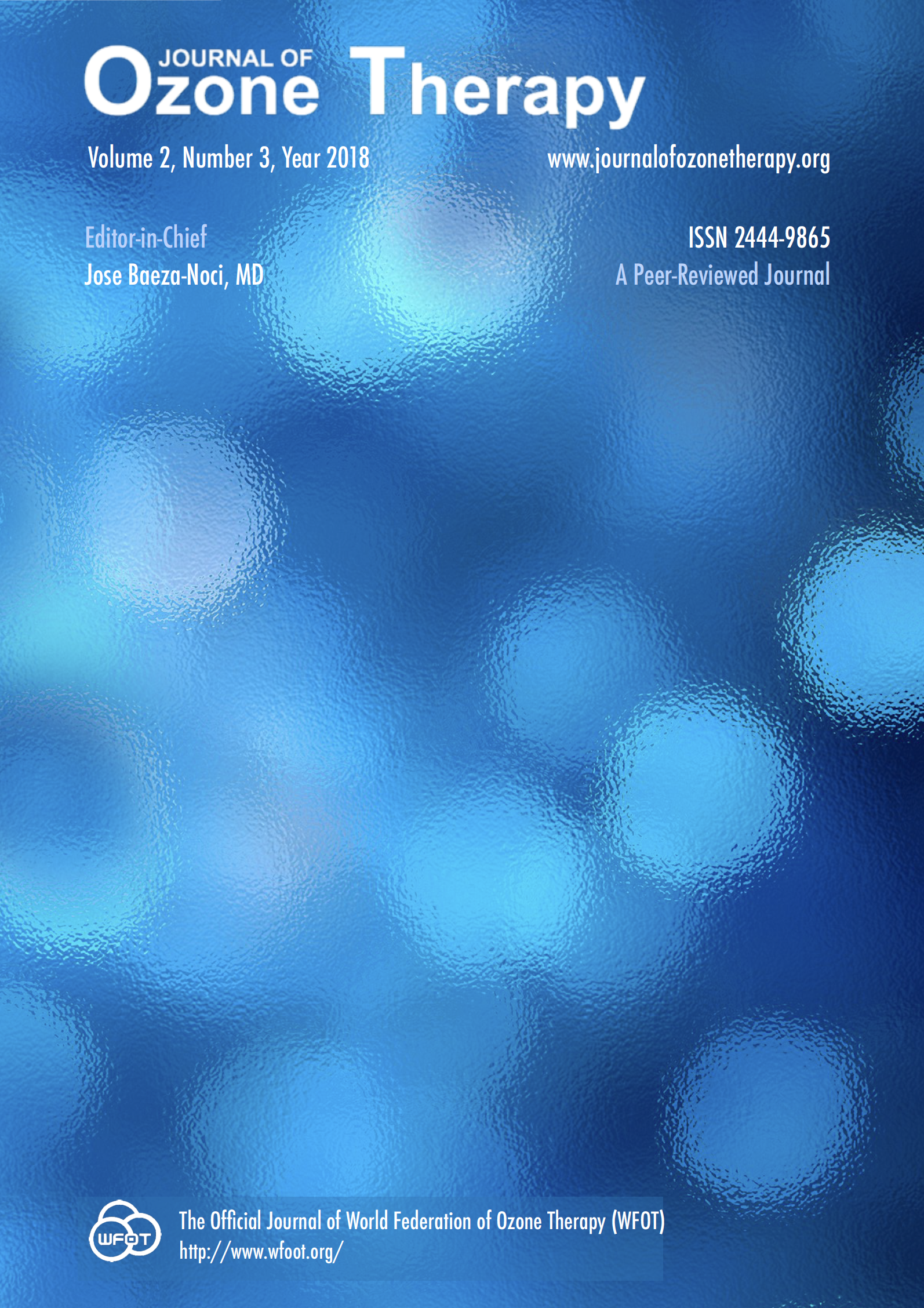Major autohemotherapy as a treatment modality for alveolar osteitis
DOI:
https://doi.org/10.7203/jo3t.2.3.2018.11292Keywords:
alveolar, osteitis, major autohemotherapy Abstract
Abstract
Purpose.
Alveolar osteitis is the most common post-odontectomy complication. Although blood clot disintegration is known to be the cause of the condition, an agreement is lacking regarding a treatment of choice. The aim of the current study therefore was to evaluate major autohemotherapy as one treatment method.
Patients and Methods.
A total of 183 patients were categorized into 4 groups (I, II, III, and IV) according to pain severity (mild, moderate, severe, or agonizing, respectively). Major autohemotherapy was performed for all patients by withdrawing 225mL of patient's blood and mixing them with 225mL of Oxygen-Ozone gas (where Ozone concentration was 50µg/mL gas)
Results and Discussion.
Despite AHT was a high-potency curative treatment for groups I and II, it was palliative for group IV. For group III, it oscillated between being a curative or a palliative treatment with a statistically insignificant difference.
Conclusion.
AHT might be a recommended treatment for AO
 Downloads
Downloads
 References
References
Kolokythas A, Olech E, Miloro M. Alveolar Osteitis: A Comprehensive Review of Concepts and Controversies. Int J Dent [Internet]. 2010;2010:1–10. Available from: http://www.pubmedcentral.nih.gov/articlerender.fcgi?artid=2905714&tool=pmcentrez&rendertype=abstract
Birn H. Etiology and pathogenesis of fibrinolytic alveolitis(“dry socket”). Int J Oral Surg [Internet]. 1973;2:215–63. Available from: https://www.sciencedirect.com/science/article/pii/S0300978573800456
Faizel S, Thomas S, Yuvaraj V, Prabhu S, Tripathi G. Comparision Between Neocone, Alvogyl and Zinc Oxide Eugenol Packing for the Treatment of Dry Socket: A Double Blind Randomised Control Trial. J Maxillofac Oral Surg [Internet]. 2014;14(2):312–20. Available from: http://www.ncbi.nlm.nih.gov/pubmed/26028852
Gowda GG, Viswanath D, Kumar M, Umashanker D. Dry Socket (Alveolar Osteitis): Incidence, Pathogenesis, Prevention and Management. J Indian Acad Oral Med Radiol [Internet]. 2013;25(3):196–9. Available from: http://www.jaypeejournals.com/eJournals/ShowText.aspx?ID=6534&Type=FREE&TYP=TOP&IN=_eJournals/images/JPLOGO.gif&IID=493&isPDF=YES
Fazakerlev M, Field E. Dry socket: a painful postextraction complication (a review). Dent Updat [Internet]. 1991;18:31–5. Available from: https://www.ncbi.nlm.nih.gov/pubmed/1936428
Alexander R. Dental extraction wound management: a case against medicating postextraction sockets. J Oral Maxillofac Surg [Internet]. 2000;58(5):538–51. Available from: https://www.ncbi.nlm.nih.gov/pubmed/10800910
Blum IR. Contemporary views on dry socket (alveolar osteitis): a clinical appraisal of standardization, aetiopathogenesis and management: a critical review. Int J Oral Maxillofac Surg [Internet]. 2002;31:309–17. Available from: http://dx.doi.org/10.1054/ijom.2002.0263
Bocci V, Zanardi I, Travagli V. Ozone: A New Therapeutic Agent in Vascular Diseases. Am J Cardiovasc Drugs [Internet]. 2011 Apr [cited 2017 Dec 22];11(2):73–82. Available from: http://link.springer.com/10.2165/11539890-000000000-00000
Bocci V, Borrelli E, Travagli, V, Zanardi I. The ozone paradox: Ozone is a strong oxidant as well as a medical drug. Med Res Rev [Internet]. 2009 Jul 1 [cited 2017 Dec 22];29(4):646–82. Available from: http://doi.wiley.com/10.1002/med.20150
Bocci V. Ozone as Janus: this controversial gas can be either toxic or medically useful. Mediators Inflamm [Internet]. 2004 [cited 2017 Dec 18];13(1):3–11. Available from: http://www.ncbi.nlm.nih.gov/pubmed/15203558
Abreu J M, Fontén N G, García A B, Rodríguez S N, Llanes E L CSM. Efficacy of OLEOZON ® compared to Alvogil in the treatment of alveolitis. J Ozone Ther [Internet]. 2015;1(1):1–8. Available from: https://www.journalofozonetherapy.org/700-2/
Bocci V. Ozone A new medical drug. 2nd ed. Dordrecht, The Netherlands: Springer Publ; 2011.
Wolff H. Die Behandlung peripherer Durchbutungsstorungen mit Ozon. Erfahr Hk. 1974;23:181–4.
Bocci V. Oxygen-ozone therapy. A critical evaluation. Dordrecht, The Netherlands: Kluwer Academic Publishers; 2002. 1–427 p.
Downloads
Published
How to Cite
-
Abstract1233
-
PDF354
Issue
Section
License
Journal of Ozone Therapy applies the Creative Commons Attribution-NonCommercial 4.0 International License (CC BY NC 4.0) license to works we publish.
Under this license, authors retain ownership of the copyright for their content, but allow anyone to download, reuse, reprint, modify, distribute and/or copy the content as long as the original authors and source are cited. No permission is required from the authors or the publishers.
You may not use the material for commercial purposes.
Appropriate attribution can be provided by simply citing the original article, provide a link to the license, and indicate if changes were made.
You may do so in any reasonable manner, but not in any way that suggests the licensor endorses you or your use.




